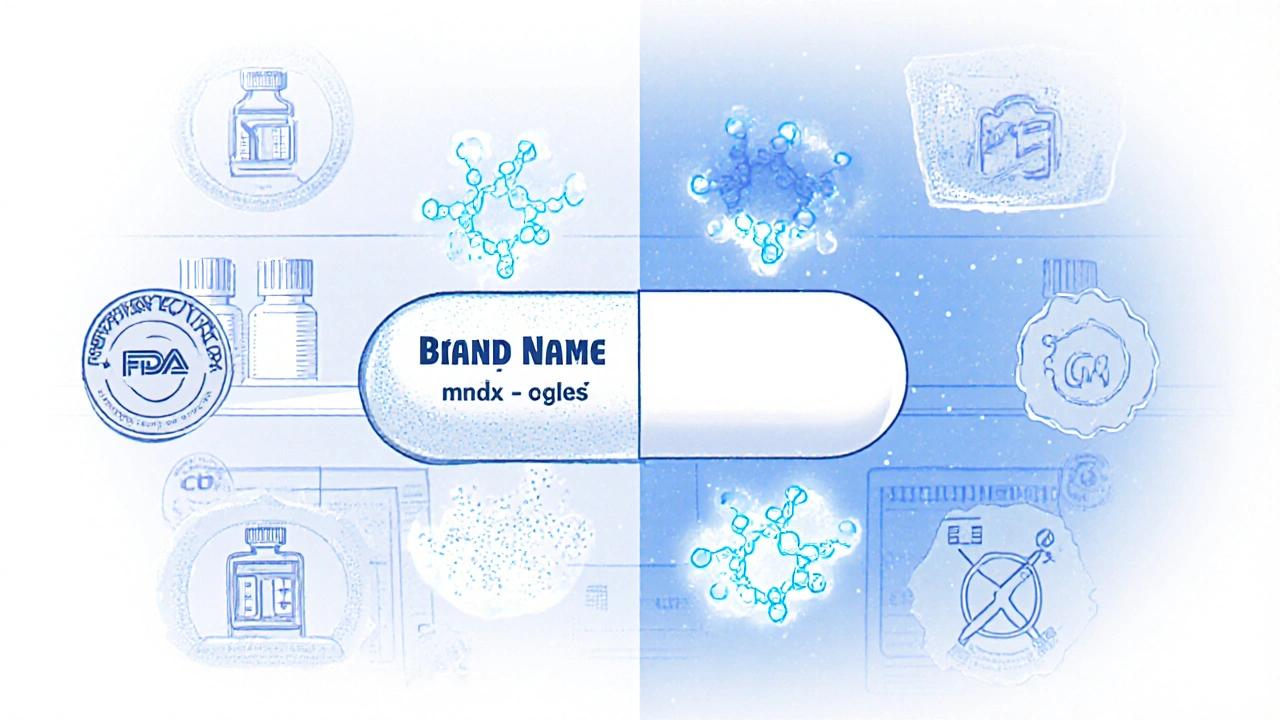When you pick up a prescription for a generic drug, you might wonder: is this really the same as the brand-name version you’ve seen advertised? It’s a fair question. After all, generics cost far less-often 80% to 90% cheaper-yet they’re expected to work just as well. The truth is, the U.S. Food and Drug Administration (FDA) holds generic drugs to the same safety and effectiveness standards as brand-name drugs. Not close. Not almost. The same.
Same Active Ingredient, Same Result
Every generic drug must contain the exact same active pharmaceutical ingredient (API) as its brand-name counterpart. That means if you’re taking a generic version of lisinopril for high blood pressure, you’re getting the same molecule as you would in Zestril. The same strength. The same dosage form-tablet, capsule, injection. The same route of administration. This isn’t a suggestion. It’s a legal requirement under 21 CFR 314.94(a). The FDA doesn’t allow any wiggle room here. If the active ingredient differs, even slightly, it’s not a generic-it’s a different drug.Bioequivalence: The Core of Generic Approval
But having the same ingredient isn’t enough. How your body absorbs and uses that ingredient matters just as much. That’s where bioequivalence comes in. To get approved, a generic drug must prove it delivers the same amount of active ingredient into your bloodstream at the same rate as the brand-name version. The FDA uses two key measurements: Cmax (the highest concentration reached) and AUC (the total exposure over time). The standard acceptance range is 80% to 125%. That means if the brand-name drug delivers 100 units of the drug into your blood, the generic must deliver between 80 and 125 units. This isn’t arbitrary. It’s based on decades of clinical data showing that within this range, there’s no meaningful difference in how the drug works in the body. For most drugs, this is perfectly safe. But for drugs with a narrow therapeutic index-like warfarin, levothyroxine, or phenytoin-the FDA tightens the rules. Here, the acceptable range shrinks to 90% to 111%. Why? Because even small changes in blood levels can lead to serious side effects or reduced effectiveness.Manufacturing Must Meet the Highest Standards
The FDA doesn’t just check the final product. It inspects how it’s made. Every generic manufacturer must follow Current Good Manufacturing Practices (cGMP). That means every step-from sourcing raw materials to packaging-is documented, controlled, and auditable. Cleaning procedures for equipment, calibration of machines, environmental controls in production rooms-all of it must meet the same standards as brand-name drugmakers. The FDA inspects over 3,500 manufacturing sites annually, and nearly half of them are overseas. In 2022, the agency increased inspections of foreign facilities by 22% to ensure quality isn’t compromised by distance. Impurities are another major focus. Even tiny amounts of unwanted substances can be dangerous. The FDA follows international guidelines (ICH Q3B and ICH M7) to set strict limits. For example, any potential carcinogen must stay below 1.5 micrograms per day-a level considered safe for lifelong exposure. Generics aren’t given a pass here. They’re held to the same purity thresholds as brand-name drugs.Dissolution and Stability: Proving It Works the Same Way
A pill that looks identical on the outside might not release its active ingredient the same way inside your body. That’s why dissolution testing is critical. The generic must dissolve at the same rate and in the same environment as the brand-name drug. If the brand uses a special coating to delay release, the generic must match it exactly-or provide strong scientific justification for a change. Stability testing is equally important. Generics must prove they remain safe and effective over their entire shelf life-usually 12 to 24 months. That means storing samples under different temperatures and humidity levels, then testing them repeatedly to make sure nothing degrades. If the brand-name drug lasts three years, the generic must prove it does too.
Labeling: Identical in Effect, Different in Details
The prescribing information for a generic drug must be the same as the brand-name version-except for a few allowed differences. You’ll see different company names, package sizes, or inactive ingredients like dyes or fillers. But the warnings, side effects, dosage instructions, and contraindications? Identical. The FDA requires this because patient safety depends on clear, consistent information. If a doctor needs to know that a drug can cause severe dizziness or interact with grapefruit juice, that warning must appear on every version of the drug, brand or generic.Complex Drugs: Where the Rules Get Tougher
Not all drugs are created equal. Simple tablets? Easy to copy. Complex products like inhalers, eye drops, or topical creams? Much harder. These drugs rely on how the active ingredient is delivered-not just what’s inside. For example, an asthma inhaler must release particles of a specific size to reach deep into the lungs. If the generic’s particle size is off by even 10%, it won’t work the same way. The FDA reports that ANDAs (Abbreviated New Drug Applications) for complex generics have a 25% higher rejection rate than conventional ones. In 2022, nearly 40% of complex generic applications were initially refused because they couldn’t prove equivalence. That’s why the agency has launched initiatives like the Complex Generic Drug Products Initiative and invested $50 million through GDUFA III to develop better testing methods. Some complex generics now require advanced techniques like pharmacodynamic studies or computer modeling to prove they work the same.Real-World Evidence: Do Generics Actually Work?
You don’t have to take the FDA’s word alone. Real-world data backs up their standards. A 2022 study in JAMA Internal Medicine tracked 38,000 Medicare patients taking generic statins. The results? No difference in heart attack risk, stroke rates, or hospitalizations compared to brand-name versions. Another analysis of 12,500 patient reviews on Drugs.com found 87% reported no difference in effectiveness between generic and brand-name cardiovascular drugs. There are exceptions, though. Some patients report feeling different on generic levothyroxine-even though bioequivalence studies show they’re within the tight 90-111% range. Why? It could be minor differences in inactive ingredients affecting absorption in sensitive individuals. That’s why the FDA recommends patients stick with one manufacturer’s version of levothyroxine if they’ve found one that works well. Switching between brands or generics can sometimes cause fluctuations in thyroid levels.
Why Generics Cost So Much Less
The price difference isn’t because generics are cheaper to make. It’s because they don’t have to repeat expensive clinical trials. Brand-name companies spend $1 billion or more to develop a new drug, including years of animal and human testing. Generics skip that. They rely on the brand’s existing data, submitting an Abbreviated New Drug Application (ANDA) instead of a full New Drug Application (NDA). That saves millions. The average bioequivalence study for a generic costs $1-2 million-still a lot, but a fraction of the original R&D cost. This system was designed by the Hatch-Waxman Act of 1984 to balance innovation and affordability. It lets generics enter the market quickly after patents expire, driving down prices without compromising safety.What the Experts Say
The American Academy of Family Physicians has repeatedly affirmed that generics are just as effective as brand-name drugs for conditions like hypertension, diabetes, and depression. Systematic reviews support this across dozens of disease areas. Some critics, including pharmacologist Joe Graedon, have raised concerns about oversight gaps, especially for complex drugs. The FDA itself acknowledges challenges. In its 2022 Science Board report, the agency admitted that current methods may not fully capture clinical performance for certain products. That’s why they’re investing in new tools-like artificial intelligence to predict dangerous impurities-and expanding inspection programs.What You Should Know as a Patient
If your doctor prescribes a generic, you can feel confident. The FDA’s standards are among the strictest in the world. Over 90% of prescriptions in the U.S. are filled with generics-and they’ve been doing this safely for decades. If you notice a change in how you feel after switching to a generic, talk to your pharmacist or doctor. It’s rare, but sometimes inactive ingredients or minor formulation differences can affect people differently. Don’t assume it’s the drug itself-ask for help figuring out what’s going on. And remember: the FDA doesn’t approve generics because they’re cheap. They approve them because they’re proven to be just as safe and effective as the original.Are generic drugs as safe as brand-name drugs?
Yes. The FDA requires generic drugs to meet the same strict standards for safety, strength, quality, purity, and performance as brand-name drugs. They must contain the same active ingredient, work the same way in the body, and be manufactured under the same quality controls. The only differences allowed are in inactive ingredients, color, shape, or packaging-all of which don’t affect how the drug works.
Why do generic drugs look different from brand-name drugs?
U.S. law requires generic drugs to look different from brand-name versions to avoid trademark infringement. That means they can have different colors, shapes, or markings. But these differences are only cosmetic. The active ingredient, dosage, and effectiveness remain identical. The FDA ensures that these visual changes don’t impact how the drug performs in your body.
Can I trust generic drugs made overseas?
Yes. The FDA inspects all manufacturing facilities-whether in the U.S., India, China, or elsewhere-using the same standards. In fact, over half of all generic drugs sold in the U.S. are made overseas, and the FDA has increased inspections of foreign sites by 22% since 2020. Every facility must comply with Current Good Manufacturing Practices (cGMP), and the FDA can refuse to approve any product from a facility that fails inspection.
Are there any drugs where generics aren’t recommended?
For most drugs, generics are just as effective. But for drugs with a narrow therapeutic index-like warfarin, levothyroxine, or certain anti-seizure medications-the FDA applies stricter bioequivalence rules. In rare cases, some patients report feeling different when switching between brands or generics. If this happens, your doctor may recommend sticking with one manufacturer’s version. Always discuss any concerns with your healthcare provider before making changes.
How long does it take for a generic drug to be approved?
The approval process for a generic drug typically takes 18 to 36 months from development to approval, depending on complexity. The FDA’s median review time for a first-cycle approval is about 10 months. For complex generics-like inhalers or injectables-the process can take longer due to additional testing requirements. The Generic Drug User Fee Amendments (GDUFA) have helped reduce review times by 35% since 2012.


Graham Holborn
Hi, I'm Caspian Osterholm, a pharmaceutical expert with a passion for writing about medication and diseases. Through years of experience in the industry, I've developed a comprehensive understanding of various medications and their impact on health. I enjoy researching and sharing my knowledge with others, aiming to inform and educate people on the importance of pharmaceuticals in managing and treating different health conditions. My ultimate goal is to help people make informed decisions about their health and well-being.